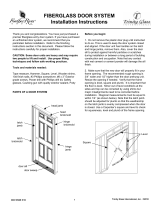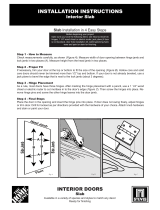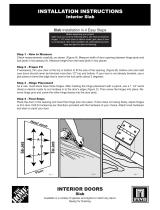Page is loading ...

© 2014 Trinity Glass International, Inc.
DOCIINDX 02/14
Installing Your New Door On
Existing Frame
1
TOOLS AND MATERIALS NEEDED
Pencil
Tape Measure
Hammer
Carpenter’s Square
Power Drill with Phillips Drill Bit
Paint/Stain
5/0 Sandpaper (180 grit)
6/0 Sandpaper (220 grit, or finer)
Paint Brush
Clean Rags
Masking Tape
SAFETY: Always use personal protective
equipment (safety glasses, gloves, ear protection,
etc.). Some door units are heavy and may require
two people to lift and install. Use proper lifting
techniques and follow safe working practices.
3. Once the locations are transferred, you will need to mark
the exact location of how far each hinge leaf will rest on
the mortise of your new door. Locate the hinge backset
to match the existing door, as shown in Figure 1a.
With a pencil, trace around the hinge leaf and score with
a razorblade. Use a hammer and wood chisel to remove
wood by lightly tapping out enough wood to make hinge
flush with door edge as shown in Figure 1b. Repeat for
each hinge.
4. If your existing door has a bevel, the same should be
made on your new door, as shown in Figure 2. Most
doors are beveled approximately 3º to 5º to prohibit door
from rubbing or sticking in jamb when closing.
BEFORE YOU BEGIN
Make sure that the new Feather River door will properly
fit into the existing frame opening. To do this, you will
need to do the following:
If your existing door fits properly, use it as a template for
your new door. If your existing 6'-8" door has only 2
hinges, a third will have to be added exactly in between
the 2 existing hinges. 8'-0" door will require 4 hinges.
Hinges are to be 3" minimum.
Depending on flooring (carpet, linoleum, laminate,
hardwood, etc.), there should be 1/8" to 1/4" clearance
between floor and bottom of door. If trimming the door
height is necessary, trim up to 1/2" at top and bottom
equally.
HINGE MORTISE
1. Make your new door the exact size and shape of
your existing door, including the locations of the
hinges and door knob. You may have to use a jack
plane to remove excess wood to match the shape of
your existing door.
2. With a pencil, mark the exact locations of the
hinges on your existing door at the top and bottom
part of each hinge leaf and transfer them to your
new door.
Figure 1
a)
b)
HINGE
BACKSET
Figure 2
BEVEL
JAMB
STOP
DOOR
Wood Chisel
Knife or Razorblade
Jack Plane
Screws
Screwdriver

© 2014 Trinity Glass International, Inc.
DOCIINDX 02/14
LOCK BORE MORTISE
1. Door may be removed from hinges to cut out lock
bore and mortise more easily. Locate the center of the
lock bore and edge bore from your existing door and
transfer the measurements to your new door. Use the
recommended backset of the new hardware or the
existing backset from your existing door. Drill the lock
bore and the edge bore as shown in Figure 3.
2. Use the face plate as a template and place over the
center of the edge bore. Take a pencil and mark all
the way around the plate. Score with razor blade and
lightly chisel out the wood deep enough so plate will
be flush with mortise.
Figure 3
LOCK BORE
EDGE BORE
FACE PLATE
MORTISE
2
5. Attach the door to hinges with #10 x 1" Phillips
flathead woodscrews. Make sure that the door opens
and closes freely without any binding or rubbing. If
there is any rubbing or contact between door and
jamb, use plane to remove wood in that area. Keep in
mind that wood doors will expand during high
humidity. If door binds, you may have to fine tune it
by inserting thin wood or cardboard shims between
door and hinge leafs.
FINISHING INSTRUCTIONS
Preparing Your New Door For Finishing
1. Mask or remove any hardware (hinges, handles,
etc.). Mask glass if applicable before painting or
staining.
2. Sand the entire surface lightly using 5/0
sandpaper (180 grit) before you apply first coat
of finish. Always sand in the direction of the
wood grain, see Figure 4.
3. Wipe dust and sand grit from the door with clean
cloth. Avoid using abrasive or caustic cleaners.
Staining/Finishing Your Wood Door
1. Complete steps 1-3 for Preparing Your New Door For
Finishing. Apply a base coat of presealer on all six sides
of door before staining. This is especially important on
pine and maple doors.
2. Stain door to desired color following stain manufacturer’s
instructions. Always stain in the direction of the wood
grain, see Figure 4.
3. For best results, apply at least two clear top coats over
stain, sanding lightly between coats. Use 6/0 (220 grit)
or finer sandpaper. Make sure that stain and top coat are
compatible materials.
Painting Primed Door
1. Complete steps 1-3 for Preparing Your New Door For
Finishing. Although primed door does not require
sanding prior to finishing, light sanding (180 grit) will
allow for optimum adhesion of paint.
2. Finish the door with two coats of latex, oil-base or
lacquer paint. Make sure to allow door to completely dry
between coats on all six sides of door. Always paint in
the direction of the wood grain, see Figure 4.
Figure 4
Note – Always
follow the stain
manufacturer’s
instructions.
/




